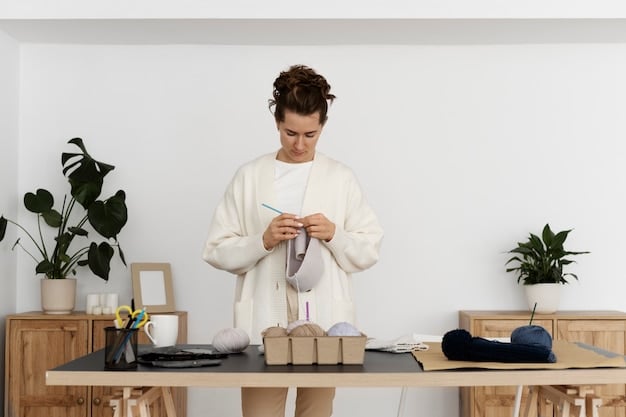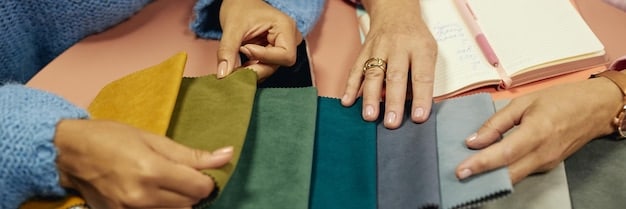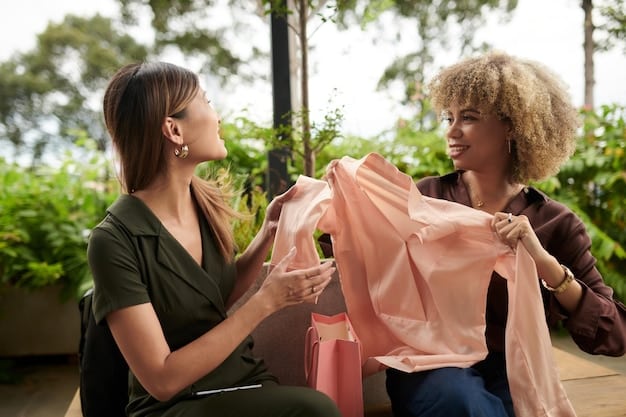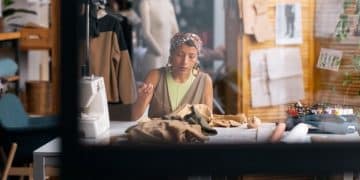Designer Spotlight: Sustainable Practices Boost US Designer Sales by 20%

This designer spotlight showcases how a US designer leveraged sustainable practices to achieve a remarkable 20% increase in sales, demonstrating the growing consumer demand for eco-conscious and ethically produced goods in the fashion industry.
Discover how one innovative US designer harnessed the power of sustainable practices to not only create stunning pieces but also achieve a remarkable 20% surge in sales. This is the story of how ethical fashion and smart business can go hand in hand, proving that sustainability isn’t just a trend—it’s a winning strategy.
The Rise of Sustainable Fashion: A Designer’s Edge
Sustainability is no longer a niche concept; it’s a core expectation for many consumers, especially in the US market. This shift has created a unique opportunity for designers who prioritize eco-friendly practices. Let’s explore how one designer capitalized on this trend to boost their sales.
Understanding the Sustainable Consumer
Today’s consumers are increasingly aware of the environmental and social impacts of their purchasing decisions. They are seeking out brands that align with their values, and they are willing to pay a premium for products that are ethically sourced and environmentally responsible.
- Transparency is key: Consumers want to know where their products come from and how they are made.
- Eco-friendly materials are a must: Designers are exploring innovative and sustainable alternatives to traditional materials.
- Ethical production matters: Fair labor practices and safe working conditions are essential.
By understanding these priorities, designers can tailor their offerings and marketing strategies to resonate with the sustainable consumer.
Embracing sustainability is not just about environmental responsibility; it’s about connecting with a growing and influential consumer base that values ethical and eco-conscious choices.

Designer’s Journey to Sustainable Success
Let’s delve into the journey of a US designer who successfully integrated sustainable practices into their business model. From sourcing materials to production processes, every step was meticulously planned and executed to minimize environmental impact and maximize ethical responsibility.
Sourcing Sustainable Materials
The foundation of any sustainable fashion brand is the materials it uses. Our featured designer prioritized sourcing materials that are either recycled, organic, or responsibly produced. This included:
- Organic cotton: Grown without harmful pesticides and using less water than conventional cotton.
- Recycled polyester: Made from recycled plastic bottles, reducing waste and conserving resources.
- Innovative plant-based materials: Exploring materials like hemp, bamboo, and even pineapple leaf fiber.
By investing in sustainable materials, the designer not only reduced their environmental footprint but also created a unique selling proposition for their brand.
The designer’s unwavering commitment to sourcing sustainable materials formed the bedrock of their success story, resonating deeply with consumers seeking eco-conscious choices.
Implementing Eco-Friendly Production Processes
Beyond materials, the designer focused on minimizing waste and reducing their environmental impact during the production phase. This involved implementing several key strategies:
Waste Reduction Strategies
Minimizing fabric waste is crucial in sustainable fashion. The designer implemented techniques such as:
- Pattern efficiency: Optimizing pattern layouts to minimize fabric scraps.
- Upcycling scraps: Using leftover fabric scraps to create new products or accessories.
- Recycling programs: Implementing recycling programs for fabric scraps that cannot be upcycled.
Water and Energy Conservation
Textile production is a water-intensive and energy-intensive process. Our designer took steps to conserve resources by:
- Using water-efficient dyeing techniques: Reducing water consumption and minimizing pollution.
- Investing in energy-efficient equipment: Reducing their carbon footprint and lowering operating costs.
- Partnering with eco-conscious factories: Ensuring that their production partners share their commitment to sustainability.
By prioritizing eco-friendly production processes, the designer not only reduced their environmental impact but also created a more efficient and cost-effective business model.
Eco-friendly production processes, coupled with responsible resource management, not only lessened environmental harm but also bolstered the brand’s credibility among discerning customers.
Marketing Sustainability: Telling the Story
Transparency is vital for sustainable brands. The designer effectively communicated their sustainable practices to consumers through compelling storytelling and clear messaging.
Communicating Authentically
Consumers are more likely to support brands that are genuine and transparent about their sustainability efforts. The designer shared their story through:
- Website and social media: Detailing their sustainable practices, materials, and production processes.
- Blog posts and articles: Educating consumers about sustainable fashion and the importance of ethical choices.
- Partnerships with influencers: Collaborating with influencers who align with their values and can amplify their message.
By being open and honest about their commitment to sustainability, the designer built trust with their customers and created a loyal following.
The designer adeptly weaved sustainability into the brand’s identity, fostering a lasting connection with consumers who valued authenticity and eco-conscious practices.

The Impact: 20% Sales Increase
The designer’s commitment to sustainability paid off in a big way—a remarkable 20% increase in sales. This success is not just a coincidence; it’s a direct result of aligning their brand with the values of today’s consumers.
Increased Brand Loyalty
Consumers who support sustainable brands are often more loyal. They appreciate the effort and investment that goes into creating ethically and environmentally responsible products. This leads to:
- Higher customer retention rates: Loyal customers are more likely to make repeat purchases.
- Positive word-of-mouth marketing: Satisfied customers are more likely to recommend the brand to others.
- Stronger brand reputation: A positive brand reputation attracts new customers and investors.
Expanded Market Reach
Sustainability appeals to a broader audience, including environmentally conscious consumers, ethical shoppers, and those who simply appreciate high-quality products. This can lead to:
- New customer segments: Attracting customers who may not have been interested in the brand otherwise.
- Increased media attention: Generating buzz and attracting positive press coverage.
- Opportunities for collaboration: Partnering with other sustainable brands and organizations.
It is clear that investing in sustainable practices is not just good for the planet; it’s also good for business.
The tangible impact of a 20% sales surge underscored the growing consumer appetite for sustainable products and the potential for brands to thrive by embracing ethical practices.
Challenges and Opportunities in Sustainable Fashion
While the benefits of sustainable fashion are clear, there are also challenges that designers must overcome. However, these challenges can also be viewed as opportunities for innovation and growth.
Cost Considerations
Sustainable materials and production processes can sometimes be more expensive than conventional options. However, this cost can be offset by:
- Increased efficiency: Reducing waste and conserving resources can lower operating costs.
- Higher profit margins: Consumers are often willing to pay a premium for sustainable products.
- Government incentives: Tax breaks and grants may be available for businesses that adopt sustainable practices.
Scaling Up Production
Meeting the demand for sustainable products can be challenging, especially for small businesses. However, this challenge can be overcome by:
- Building strong relationships with suppliers: Ensuring a reliable supply of sustainable materials.
- Investing in automation: Increasing production efficiency without sacrificing quality.
- Collaborating with other businesses: Sharing resources and expertise to scale up production.
Continuous Improvement
Sustainability is not a static concept; it’s an ongoing journey of learning and improvement. Designers must continually seek out new ways to reduce their environmental impact and improve their ethical standards. This includes:
- Staying up-to-date on the latest sustainable innovations: Exploring new materials, technologies, and practices.
- Soliciting feedback from customers and stakeholders: Identifying areas for improvement and addressing concerns.
- Measuring and tracking their environmental and social performance: Setting goals and monitoring their progress.
By embracing these challenges as opportunities, designers can create truly sustainable and successful businesses.
The path to sustainability, while demanding, offers avenues for innovation, cost-effectiveness, and continuous improvement, ultimately shaping a more responsible and resilient industry.
| Key Point | Brief Description |
|---|---|
| 🌱 Sustainable Materials | Using organic, recycled, or plant-based materials reduces environmental impact. |
| 🔄 Eco-Friendly Production | Minimizing waste and conserving water/energy in manufacturing processes. |
| 📣 Transparent Marketing | Communicating sustainable practices builds trust with consumers. |
| 📈 Sales Increase | Sustainable practices can lead to significant sales growth (e.g., 20% increase). |
Frequently Asked Questions
▼
Sustainable materials reduce environmental impact by minimizing waste, conserving resources, and avoiding harmful chemicals. They also often align with ethical labor practices.
▼
Designers should be transparent about their practices on their website, social media, and through blog posts. Collaborating with influencers and certifications can also boost credibility.
▼
Common challenges include higher initial costs, difficulty scaling production, and the need for continuous improvement to stay updated on best practices.
▼
Sustainability often leads to higher customer loyalty and retention as consumers appreciate the brand’s ethical values, leading to repeat purchases and positive word-of-mouth.
▼
Consumers play a crucial role by supporting sustainable brands, demanding transparency, and making informed purchasing decisions that prioritize ethical and environmental considerations.
Conclusion
The success story of this US designer serves as a powerful example of how sustainability can drive sales and build a loyal customer base. By prioritizing eco-friendly practices and transparent communication, designers can create a positive impact on both the planet and their bottom line, setting a new standard for the fashion industry.





